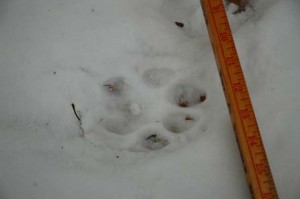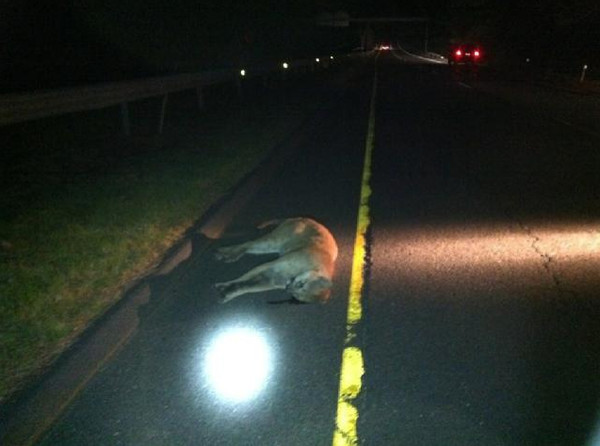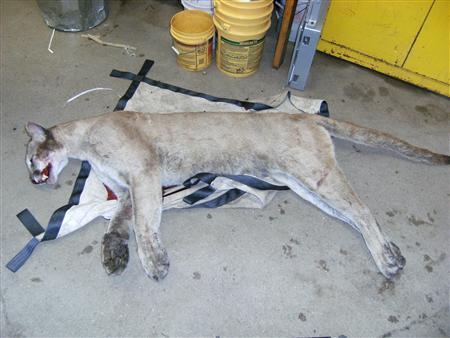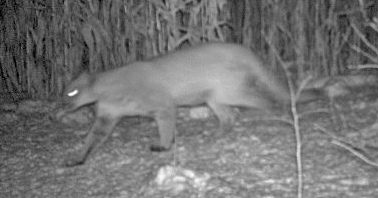Retro-Explaining: Dead Connecticut Cougar Said To Have Been In New York…As Well As Michigan, Wisconsin, Minnesota And South Dakota!
Posted by: Loren Coleman on August 23rd, 2011

Mystery cat track in Lake George, New York, is now linked to a recently dead cougar. NY Department of Environmental Conservation photo.

Mountain lion killed on Rt 15, Milford, Connecticut. Michael Dinan photo.
Environmental officials say a cougar killed by a car in Connecticut traveled through upstate New York last year (2010). They contend it was a rare sighting in a state where the big cats are considered to have been extinct for more than a century.

Connecticut cougar, after removal from Rt. 15.
Cindy Eggleston reported seeing the cat in her Lake George, New York backyard in December 2010. Her husband David, a former NY Department of Environmental Conservation colonel, and NY DEC officer Louis Gerrain took pictures of the tracks and gathered hairs.
When a cat was struck and killed in June 2011 further east, analysis, it is being reported today, confirmed it was the same cougar. The New York Department of Environmental Conservation states that cougars were extirpated from the Adirondacks in the nineteenth century, though some people contend that a remnant population continues to dwell in the region.
DNA analysis of the hairs indicated that they came from the same cougar that was killed by a car on a highway in Milford, Connecticut, on June 11. Previously, DNA tests of the Connecticut cougar showed that it was the same cougar that had been tracked in Minnesota and Wisconsin and that it came from a breeding population in the Black Hills of South Dakota.
The cougar was first detected in Minnesota in December 2009 and then tracked as it wandered through Wisconsin. In May 2010, a cougar was caught on trail cameras near the border of Wisconsin and the Upper Peninsula of Michigan. Scientists believe it was the same cougar. Presumably, it traveled through the Upper Peninsula into Ontario and then headed south, eventually passing through the Adirondacks.Phil Brown, Albany Times-Union

A cougar photographed in Wisconsin on January 18, 2010. Wisconsin Department of Natural Resources photo.

On May 20, 2010, a trail camera photographed a young cougar in Oconto County, Wisconsin, and six days later a trail camera in Michigan’s Upper Peninsula photographed what biologists believe to be the same animal. (However, no DNA samples from these two May 2010 photographed incidents exist to definitely confirm this theory, I must point out. Loren)
Authorities believe the 140-pound male mountain lion started its journey in South Dakota and came about 2,000 miles. Mountain lions/pumas rarely traveling more than 100 miles.
Why do I get the creepy feeling that this one dead cougar in Connecticut is now being used by U.S. wildlife officials to explain several recent confirmed puma sightings in the Midwest and East – sort of like how a confessed serial killer is used to “clear the books” on unsolved murder cases?
About Loren Coleman
Loren Coleman is one of the world’s leading cryptozoologists, some say “the” leading living cryptozoologist. Certainly, he is acknowledged as the current living American researcher and writer who has most popularized cryptozoology in the late 20th and early 21st centuries.
Starting his fieldwork and investigations in 1960, after traveling and trekking extensively in pursuit of cryptozoological mysteries, Coleman began writing to share his experiences in 1969. An honorary member of Ivan T. Sanderson’s Society for the Investigation of the Unexplained in the 1970s, Coleman has been bestowed with similar honorary memberships of the North Idaho College Cryptozoology Club in 1983, and in subsequent years, that of the British Columbia Scientific Cryptozoology Club, CryptoSafari International, and other international organizations. He was also a Life Member and Benefactor of the International Society of Cryptozoology (now-defunct).
Loren Coleman’s daily blog, as a member of the Cryptomundo Team, served as an ongoing avenue of communication for the ever-growing body of cryptozoo news from 2005 through 2013. He returned as an infrequent contributor beginning Halloween week of 2015.
Coleman is the founder in 2003, and current director of the International Cryptozoology Museum in Portland, Maine.










I have been following this story with tredipation. There were numerous sightenings of a cat in Greenwich Ct. but according to the Ct. DEEP these sightenings were not credible. Not credible that is until someone took a photo of the cat in their backyard (OOPS). Must be an “escaped exotic”. The cat above was killed some forty miles north of Greenwich on a Sat. night and was immediately linked to the Greenwich cat even though there were several sightenings once again in Greenwich on Sunday morning (its ghost).The DEEP once again publically claimed this was not credible. A local newspaper interviewed the family of four that observed the cat for minutes in their back yard and watched it scale an eight foot wall in one leap. This plus the fact that the cat that was killed had to swim across the Housatonic River or cross over the bridge (hope he had an EZ-Pass) if it traveled from Greenwich.
There are still reports of a cougar in Greenwich as of recent.
Because that’s what “experts” do when they’re proven wrong. Next, they’ll say it taught itself to walk up right and spend time in the Pacific Northwest. Before that it swam across Lake Champlain in the summer, after it presided over a bipartisan budget agreement.
i think it’s safe to say that this cat got around.
After reading the news story linked by CryptoNY I am a bit confused. The DEEP rep. the reporter spoke to said they hadn’t investigated the reports due to lack of evidence? The dead Cougar on the side of the road seems to point to eyewitness reports being correct, doesn’t it? Now they are getting more eyewitness reports and still say not enough evidence. I always thought investigating is what “experts” in a given field did to gather evidence, not the general public that pays said “experts” salary.
I hope the people in the area raise a huge fuss over this. It is a safety concern for their children and pets. Sure the authorities will claim ‘escaped exotic’ as they always seem to do but this was a male cat, more than likely roaming and mating with other mountain lions.
I do find it a bit far reaching of the authorities to claim that this is ‘probably’ the same cat from the Mid-West. Sure, it is possible as most large predators will travel to where the resources are plentiful and competition is low, but that’s a LOT of miles for a single animal to travel in a year and a half.
We just don’t know as much about these cats as we think we do.
Hmmmm. Maybe we *are* seeing Cougar Denial: The Next Generation.
“No, ma’am. This one came all the way to Maine from northern British Columbia. There aren’t any others.”
Or maybe it’s the real deal. To paraphrase Roger Tory Peterson on vagrant birds: Animals have legs, and they do things.
A black bear was killed in St. Mary’s County, Maryland, in 1985. All indications were of a wild animal…and the nearest MD bear habitat at the time was about six hours’ drive away. (The nearest habitat in VA: farther.) That’s not ND to CN, but point made.
I don’t think they quite match up. In the first may picture, you can see lots of color variation between light and dark, and in the dead cougar picture I can’t see anything. Also, in the blurry picture, you can clearly see a dark streak going straight up the inside of one of the front paws, and on the dead one it is diagonal.
Living in West Ga, we have been told by local game wardens that there are absolutely no big cats and haven’t been for centuries. I have seen a black panther, no question what it was and I have quite a few friends who have seen them/ heard them (very distinct scream not a bobcat or feral cat, etc.) hunting. I think that a concerted crypto search for those instead of bigfoot in Georgia would yield some real results.
Not even wrong,
Wasn’t a panther killed in west Georgia in the last few years?